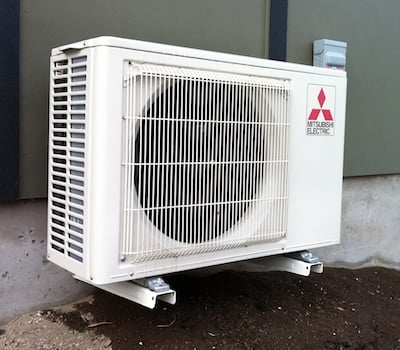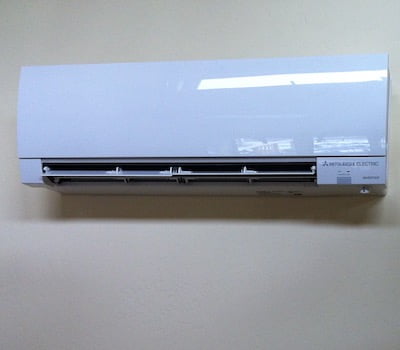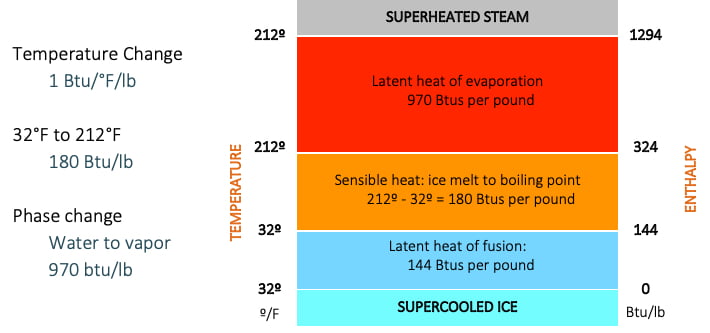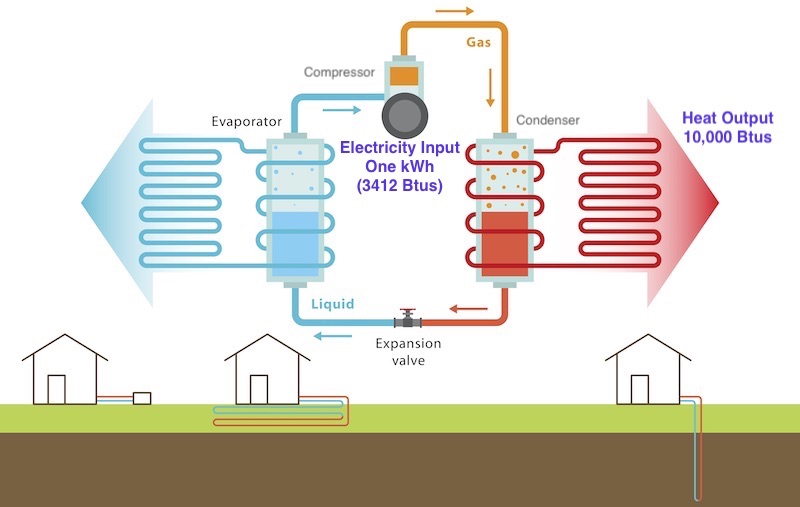We take it for granted. Refrigerators draw heat from inside a cold cabinet and they reject that heat into the surrounding air. You can feel the heat in the space behind a refrigerator. Pulling heat out of seemingly cold air may seem like magic. But it’s just basic physics. The principle of refrigeration was first discovered in the 1700s and an early version of the technology was commercialized about a hundred years later. So, it’s not magic. It’s not even new. During the 20th century, refrigeration technology in the form of “air-conditioning,” expanded into automobiles and entire buildings. Soon air-conditioning became a modern necessity. While early practice focused on cooling and dehumidification, the physical principle has been adapted to work in either direction – expanding the magic to space heating as well as cooling applications. Now, specialized refrigeration products can dehumidify air, dry clothes, and heat water.
When space heating, air-source heat pumps first appeared on the market, they were basically air-conditioners that had been adapted to operate in reverse. They were limited to warmer climates and mild heating seasons. Gradually, the technology improved with a surge of efficiency. Over time, engineers have expanded the range and function of heat pumps so they work well in colder climates, too. While it may seem like magic, heat pumps are all science. The technology employs several basic principles of physics to attract outdoor heat, concentrate it, and move it between indoors and outdoors. Understanding the science will help you understand and appreciate what a wonderful contribution air source heat pumps are making to zero energy homes.
Energy Moves
In nature, nothing remains still. Heat is always moving from areas of higher temperature to lower temperature. If you want to attract heat, you must present a surface that is cooler than its surroundings. To reject heat, present a warmer surface. Although an air temperature of zero degrees seems cold, there is actually quite a lot of energy in that air. To attract this energy, a heat pump presents a cold surface to the outside air in the form of a fin-and-tube heat exchanger in the outdoor unit.


A heat pump’s outdoor unit (left) captures heat, concentrates it and moves it to the indoor unit (right). The system can be operated in either direction for heating or cooling.
To function, the outdoor heat exchanger must be quite a bit colder than the outdoor air. Similarly, to send heat into the indoor space, the indoor heat exchanger must be warmer than the indoor air. So, how does it make cold on the outside and warm on the inside?
States of Matter
All matter comes in three states: solid, liquid, and vapor. To keep things simple, let’s look at water which we see everyday in all three states. It takes one British Thermal Unit (Btu) of energy to raise one pound of water one degree Fahrenheit. (This happens to be the definition of a Btu.) If you start with liquid water at 32°F and apply 180 Btus, you have liquid water at 212°F – the boiling point of water. But wait, shouldn’t liquid water become vapor at this point? Not yet, because it takes 970 Btus more energy to turn this water from liquid to vapor. That’s 5 times MORE energy to change the state from liquid to vapor than it took to raise the temperature of the water. This is called the energy of vaporization or evaporation.

Source: Earth Advantage
Refrigeration technology captures this principle of physics to move energy from one place to another using a refrigerant. There are many types of refrigerants, but they all share an important property. They evaporate – or vaporize – at a very low temperature.
Pressure and Temperature
In heating mode, a heat pump circulates a very cold liquid refrigerant through the outside coil. Because the refrigerant is colder than the outside air, the liquid vaporizes even at a temperature people consider cold. The refrigerant captures a lot of energy and becomes a gas that can be pushed inside the building. The pushing is accomplished by a compressor, but moving the energy-rich gas is only one of its functions. The compressor also squeezes the gas, increasing it’s pressure. When pressure increases, so does temperature. So now, the gas is hot and moving through a heat exchanger inside the building. Here the refrigerant condenses back into a liquid, releasing the same amount of heat that it absorbed in the outdoor coil plus the heat added by compression. A fan circulates room air through the coils delivering the heat to the room. This process is highly efficient because the compressor and two fans are the main components that use energy. There is no combustion of fossil fuel or an inefficient electric resistance coil.
Refrigerants Evolve
Water can be used as a refrigerant although it’s properties are not ideal. Fifty years ago, chlorinated fluorocarbons (CFCs) were common. Many people remember Freon, a brand name for the refrigerant R12. CFCs were phased out through the Montreal Protocol because they destroyed the ozone layer. Ammonia is used as refrigerant in large industrial systems. Many modern air-conditioners and heat pumps now use hydrofluorocarbons (HFCs) such as R134a and R410a. While these are ozone-friendly and have many other admirable properties, these HFC-based refrigerants are strong greenhouse gases. If they escape from the sealed heat pump system, they have a powerful warming effect in the atmosphere. Refrigerant production and use are regulated and heat pump installers must be licensed. Nevertheless, HFC refrigerants are causing harm to the climate. They are already being phased out and will soon be replaced with ozone and climate-friendly alternatives.
One refrigerant with a low global warming potential (GWP) is carbon-dioxide. CO2 has a GWP of 1. It is used in the Sanden Heat Pump Water Heater. A new class of refrigerants is entering the market called hydrofluoroolefins (HFOs) which have a global warming potential similar to carbon-dioxide. These low GWP refrigerants are now on the market under the brand names Opteon and Solstice. Both products can be used to replace the HFC refrigerants in existing HVAC equipment. Better still, new HVAC products are being developed to utilize these low greenhouse gas emitting refrigerants.
Unfortunately, the Federal Government just reversed regulations on large-scale refrigeration systems, such as supermarket equipment, which will undoubtedly lead to massive leakage of CFC and HFC into the atmosphere.
Efficiency
Heat pump efficiency is expressed as Coefficient of Performance (COP) which is a ratio of heat output to electricity input under specific testing conditions. For space heating applications, a more useful metric is Heating Season Performance Factor (HSPF). This number incorporates a wider range of conditions that better capture real world operation. Modern mini-split heat pumps offer HSPFs ranging from 9 to 13 compared to less than 9 for most central air-source heat pumps.
Heat pump technology is vital to the zero energy movement because it is both highly efficient and versatile. Heat pumps can heat a home, cool a home, heat water, dehumidify air, and dry clothes with much greater efficiency than standard technology. For example, a heat pump water heater can make 3 units of hot water while consuming only one unit of electricity. By contrast, a natural gas fired water heater makes between 0.60 (tank-style) and 0.95 (tankless) units of hot water for each unit of fuel burned. Not to mention, natural gas is a carbon based fossil fuel. The electricity required to power an air-source source heat pump can be provided by renewable electricity generated on-site from solar panels on zero energy homes or purchased from a utility that obtains its electricity from renewable sources.
Renewable energys already contributes a significant amount of power to the utility grid and the percentage increases each year. Combining renewable electricity with a variety of heat pump applications is a win for zero energy homes and for the climate. The future is electric. And it’s exactly the kind of science-based magic we need.



Steve says:
It would be useful if you also discussed ground source heat pumps, the more efficient cousin of air sourced heat pumps.
Bruce Sullivan says:
Thanks for mentioning ground source heat pumps. They are quite efficient and well-suited to commercial buildings and perhaps larger homes. What I’ve seen in the last few years, is that the performance of cold-climate, air-source heat pumps has equaled or surpassed ground source in many situations. A limitation of ground source heat pumps is the space needed for the ground loops not to mention the extra expense which can match the cost of the equipment inside a home. At ZEP, we promote right-sized residential buildings. Mini-splits are a perfect match for this situation. Again, ground source is great for certain situations, including very cold climates and larger buildings. We will certainly cover them in the future.
Clover Rayner says:
This is a summary of two months of research that we did into renewable energy and net-zero buildings with the intention of starting a company in the space. The post outlines the opportunity and challenges of using geothermal heat pumps to heat and cool homes in the US. We interviewed researchers, contractors and home owners to understand the technology and how people think about replacing heating systems in their homes.
moring says:
It took 80 years after Dr. Gorrie invented the crude ice-maker technique for someone to create a chemical that was secure, non-toxic, and simple to manufacture and that could be utilized to cool buildings for the general public. CFC refrigerants were developed by Thomas Midgley, Albert Henne, and Robert McNary in 1928.